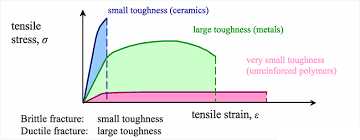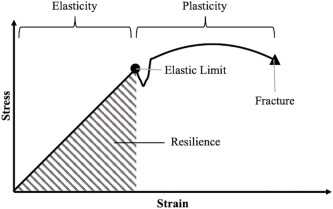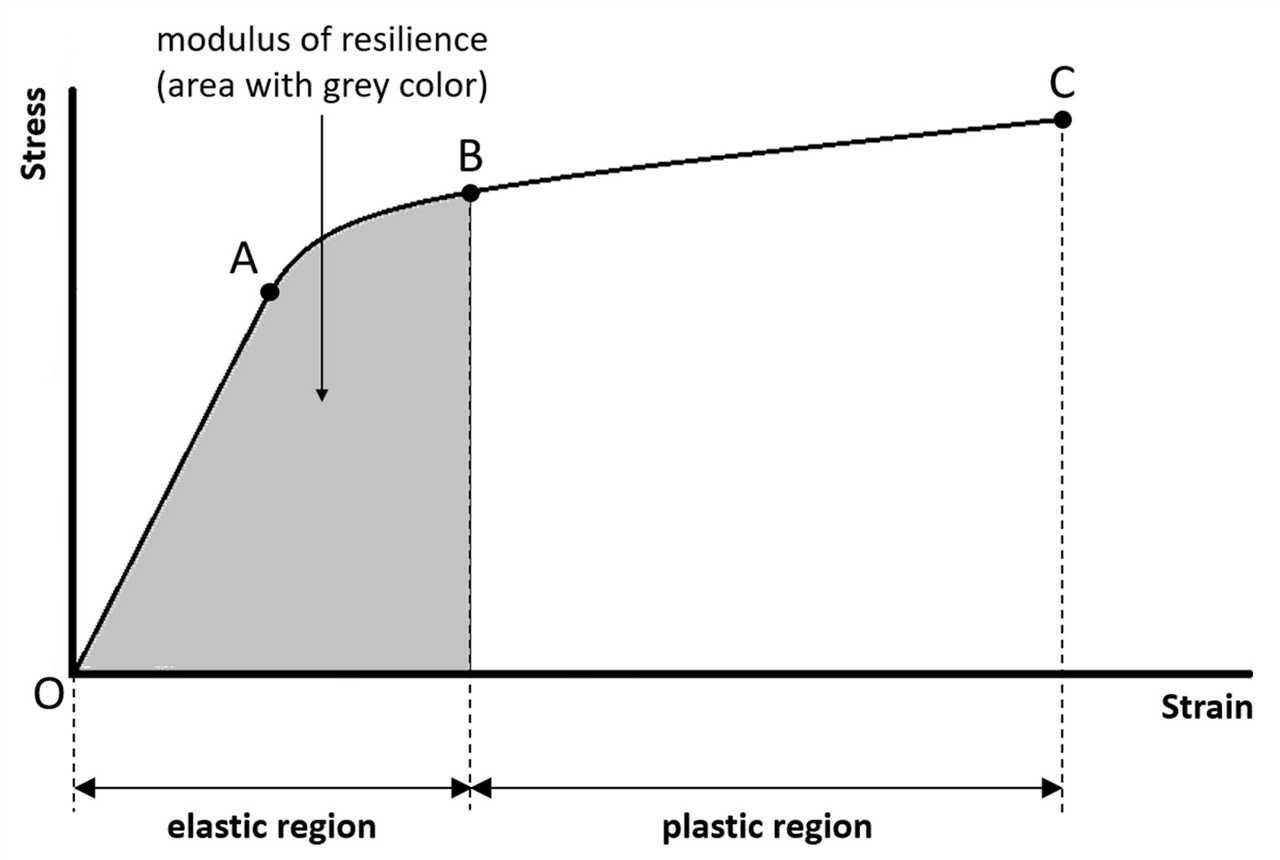
When it comes to understanding the behavior of materials under stress, the stress-strain curve is an invaluable tool. This curve provides insights into the resilience of a material and how it responds to external forces. However, not all materials exhibit positive resilience. In fact, some materials display negative resilience, which can have significant implications in various fields of science and engineering.
The stress-strain curve is a graphical representation of the relationship between stress and strain in a material. Stress refers to the internal force experienced by a material, while strain measures the deformation or change in shape that occurs as a result of the applied stress. By plotting stress against strain, we can gain a better understanding of how a material behaves under different levels of stress.
Positive resilience is typically associated with materials that can withstand high levels of stress without permanent deformation. These materials exhibit a linear or elastic region on the stress-strain curve, where the material deforms elastically and returns to its original shape once the stress is removed. However, in some cases, materials exhibit negative resilience, where the stress-strain curve shows a decrease in stress with increasing strain.
Understanding negative resilience is crucial in fields such as materials science, structural engineering, and biomechanics. It can help identify materials that are prone to failure or deformation under stress, allowing for better design and selection of materials. By studying the stress-strain curve and analyzing the factors that contribute to negative resilience, researchers and engineers can develop strategies to improve the performance and durability of materials.
What is Negative Resilience?

Negative resilience refers to the tendency of a material or structure to undergo permanent deformation or failure when subjected to stress. It is the opposite of resilience, which is the ability of a material to recover its original shape and size after being deformed.
When a material is subjected to stress, it undergoes a change in shape or size, known as strain. The stress-strain curve is a graphical representation of the relationship between stress and strain, showing how a material responds to applied forces.
In the context of the stress-strain curve, negative resilience occurs when a material or structure does not exhibit elastic behavior. Instead, it undergoes plastic deformation, meaning that it deforms permanently and does not return to its original shape and size when the stress is removed.
Materials with negative resilience may experience necking, where localized regions of the material undergo significant deformation and become weaker. This can lead to failure or fracture of the material.
Understanding negative resilience is important in engineering and materials science, as it can help predict the behavior of materials under different loading conditions. By analyzing the stress-strain curve, engineers can determine the point at which a material will undergo plastic deformation and potentially fail.
Overall, negative resilience represents a limitation in the mechanical properties of a material or structure, as it reduces its ability to withstand stress without permanent deformation or failure.
Definition of Negative Resilience

Negative resilience refers to the lack of ability of a material or structure to withstand stress and return to its original state. It is a measure of the material’s susceptibility to deformation or failure when subjected to external forces.
In the context of the stress-strain curve, negative resilience is represented by a downward slope in the curve, indicating that the material is unable to recover its original shape after being subjected to stress. This can occur due to various factors such as material defects, improper design, or excessive load.
When a material exhibits negative resilience, it may experience permanent deformation or even failure when subjected to stress. This can have detrimental effects on the performance and longevity of structures or components made from the material.
Understanding negative resilience is crucial in engineering and material science, as it allows for the identification and mitigation of potential failure points. By analyzing the stress-strain curve, engineers can determine the material’s ability to withstand stress and design structures that can better withstand external forces.
Causes of Negative Resilience

There are several factors that can contribute to negative resilience in materials. One of the main causes is excessive strain. When a material is subjected to too much strain, it can exceed its elastic limit and become permanently deformed. This can weaken the material and reduce its ability to recover from stress.
Another cause of negative resilience is high levels of stress. When a material is exposed to high levels of stress, it can lead to the formation of microcracks or other defects. These defects can act as stress concentrators, causing the material to fail more easily and reducing its resilience.
In addition, the presence of impurities or defects in the material can also contribute to negative resilience. These impurities or defects can weaken the material’s structure and make it more prone to failure under stress.
Furthermore, environmental factors such as temperature and humidity can also affect a material’s resilience. Extreme temperatures or moisture can cause the material to degrade or corrode, reducing its overall resilience.
In summary, excessive strain, high levels of stress, impurities or defects, and environmental factors can all contribute to negative resilience in materials. Understanding these causes is important in order to design materials with improved resilience and durability.
Understanding the Stress-Strain Curve

The stress-strain curve is a graphical representation of the relationship between the stress applied to a material and the resulting strain. It is a fundamental concept in materials science and engineering, as it provides valuable insights into the mechanical behavior of materials under different loading conditions.
Resilience, in the context of the stress-strain curve, refers to the ability of a material to absorb energy without undergoing permanent deformation or failure. It is represented by the area under the elastic portion of the curve, which shows the material’s ability to return to its original shape after the applied stress is removed.
The stress-strain curve typically consists of several distinct regions. The initial portion of the curve, called the elastic region, represents the linear relationship between stress and strain. In this region, the material behaves elastically, meaning it deforms under stress but returns to its original shape when the stress is removed.
As the stress increases, the material enters the plastic region, where it undergoes permanent deformation. The stress-strain curve in this region is nonlinear, indicating that the material’s response is no longer proportional to the applied stress. Plastic deformation occurs due to the movement of dislocations within the material’s crystal structure.
At high stress levels, the material reaches its ultimate tensile strength, beyond which it undergoes necking and eventual failure. The stress-strain curve in this region shows a rapid decrease in stress with increasing strain, indicating the material’s inability to withstand further deformation.
Negative resilience, on the other hand, refers to the inability of a material to absorb energy and return to its original shape. It is represented by the area under the plastic portion of the stress-strain curve, which indicates the energy dissipated as heat during plastic deformation.
Understanding the stress-strain curve and its various regions is crucial for engineers and scientists in designing and selecting materials for specific applications. By analyzing the curve, they can determine the material’s strength, ductility, and overall mechanical behavior under different loading conditions.
Key Points of the Stress-Strain Curve

The stress-strain curve is a graphical representation of the relationship between stress and strain in a material. It is an important tool in understanding the behavior of materials under different loading conditions.
There are several key points on the stress-strain curve that provide valuable information about the material’s properties:
1. Elastic Region: The curve starts at the origin and initially follows a linear path. This region represents the elastic deformation of the material, where it can return to its original shape after the stress is removed. The slope of this region is known as the Young’s modulus, which indicates the material’s stiffness.
2. Yield Point: The curve deviates from the linear path and enters the plastic region. The yield point is the stress at which the material starts to deform permanently. It indicates the onset of plastic deformation and the limit of the material’s elastic behavior.
3. Plastic Region: In this region, the material undergoes permanent deformation without a significant increase in stress. The curve continues to rise until it reaches the ultimate tensile strength.
4. Ultimate Tensile Strength: This is the maximum stress that a material can withstand before failure. It represents the material’s ability to resist breaking under tension.
5. Fracture Point: Beyond the ultimate tensile strength, the material fails and fractures. The stress rapidly decreases, indicating the loss of load-bearing capacity.
Understanding the stress-strain curve and its key points is essential for predicting the behavior of materials under different loading conditions. It helps engineers design structures that can withstand the expected stresses and strains, ensuring their safety and longevity.
Interpreting the Stress-Strain Curve

The stress-strain curve is a graphical representation of the relationship between stress and strain in a material. It provides valuable insights into the behavior and properties of a material under different loading conditions. Understanding and interpreting this curve is essential for engineers and material scientists in designing and analyzing structures and materials.
The curve typically consists of two distinct regions: the elastic region and the plastic region. In the elastic region, the material deforms under the applied stress but returns to its original shape once the stress is removed. This region represents the material’s ability to withstand deformation without permanent damage, known as its resilience.
However, in the negative resilience region of the stress-strain curve, the material exhibits a decrease in stress with increasing strain. This behavior indicates that the material is becoming weaker and less resistant to deformation. It may be caused by various factors such as microstructural changes, defects, or the presence of impurities in the material.
Interpreting the negative resilience region of the stress-strain curve is crucial in identifying potential weaknesses or failure points in a material. Engineers can use this information to modify the material composition or design to improve its overall strength and performance.
Furthermore, the stress-strain curve can also provide insights into the material’s ductility or brittleness. Materials that exhibit a gradual decrease in stress and strain before failure are considered ductile, while those that fail abruptly without much deformation are considered brittle. This information is vital in selecting materials for specific applications where ductility or brittleness is a critical factor.
In conclusion, interpreting the stress-strain curve, including the negative resilience region, is essential for understanding the behavior and properties of materials under different loading conditions. It helps engineers and material scientists make informed decisions in designing and analyzing structures and materials to ensure their strength, durability, and overall performance.
Implications of Negative Resilience

Negative resilience, as observed in the stress-strain curve, has several implications in various fields. Understanding these implications is crucial for addressing and mitigating the negative effects of stress and strain.
- Health: Negative resilience in the stress-strain curve can have detrimental effects on an individual’s health. Prolonged exposure to stress and strain can lead to physical and mental health issues, such as chronic pain, cardiovascular problems, anxiety, and depression. It is important to recognize and manage stress levels to maintain overall well-being.
- Engineering: In the field of engineering, negative resilience in the stress-strain curve can indicate structural weaknesses or flaws in materials. It highlights the point at which a material or structure fails under stress, providing insights for improving design and construction processes. Engineers can use this information to enhance the resilience of structures and materials, ensuring their durability and safety.
- Psychology: Negative resilience in the stress-strain curve can be related to psychological resilience in individuals. It represents the point at which an individual’s ability to cope with stress and adversity diminishes, leading to negative outcomes. Understanding this concept can help psychologists develop interventions and strategies to enhance resilience and promote mental well-being.
- Business: Negative resilience in the stress-strain curve can also have implications for businesses. The curve can be seen as a representation of the stress levels experienced by employees and the strain it puts on their performance. High levels of stress can lead to decreased productivity, increased absenteeism, and higher turnover rates. Businesses need to prioritize employee well-being and implement strategies to manage and reduce stress levels.
Overall, negative resilience in the stress-strain curve has wide-ranging implications across various fields. Recognizing and addressing the factors that contribute to negative resilience is essential for promoting health, enhancing engineering practices, improving psychological well-being, and fostering a productive work environment.
Effects of Negative Resilience on Materials

Resilience is the ability of a material to absorb energy when it is deformed and then release that energy upon unloading. It is a measure of the material’s ability to withstand stress and return to its original shape. A stress-strain curve is commonly used to represent the resilience of a material.
However, in some cases, materials may exhibit negative resilience. Negative resilience occurs when a material fails to return to its original shape after being deformed. Instead, it retains a permanent deformation or undergoes further deformation.
This phenomenon can have detrimental effects on the performance and durability of materials. When a material exhibits negative resilience, it is unable to absorb and release energy efficiently, leading to reduced mechanical properties and increased vulnerability to failure.
Materials with negative resilience may experience a decrease in strength, stiffness, and ductility. They may also exhibit increased brittleness, making them more prone to fracture and failure. Additionally, materials with negative resilience may undergo stress concentration, leading to localized deformation and potential structural damage.
Understanding the effects of negative resilience is crucial for engineers and designers in various industries. It helps in selecting appropriate materials for specific applications, ensuring the longevity and reliability of structures and products.
In conclusion, negative resilience has significant implications on the behavior and performance of materials. It can compromise their mechanical properties and structural integrity, making them more susceptible to failure. Therefore, it is important to consider the resilience characteristics of materials when designing and using them in various applications.

I am Patrina de Silva, a psychologist and mental health blogger in Sri Lanka. After obtaining psychology degrees from the University of Colombo and Monash University, I returned home to work as a counselor while also starting the popular blog “Pressy but Happy” to provide advice on psychological issues. Over the past decade, my empathetic articles have made my blog a leading mental health resource in the country. In addition to writing, I maintain a private therapy practice, frequently volunteer counseling time, and conduct seminars, driven by my passion for destigmatizing mental illness and educating the public on the mind-body connection. I strive to be an influential voice in my field through my compassionate approach.
